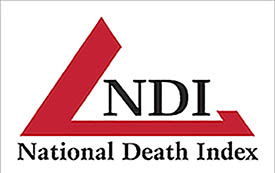News You Can Use: National Death Index
Access to the National Death Index Made Easy
Centralized Database Now Available to NIH-supported Researchers

For many long-term clinical studies, it is critical for investigators to know whether patients have died, and if so, when, where, and how. Unfortunately, this information—especially if the patients died outside the research hospital—has often been difficult and expensive to obtain. Recently, NIH has made it easier—and free—for NIH-supported epidemiologists and other health and medical researchers to access a centralized database of death-record information held by state vital statistics offices.
It can be incredibly hard to study the natural history of a disease without patient data that show whether people have died and the causes of death, said John Gallin, chief scientific officer of the NIH Clinical Center and NIH associate director for clinical research. He’s been studying a genetic immunodeficiency disorder called chronic granulomatous disease for almost 40 years. Although he and other NIH-supported researchers (both intramural and extramural) could access death records through the Social Security Administration or the Center for Disease Control’s National Center for Health Statistics (NCHS)—which provided access to the National Death Index (NDI)—the process was becoming more difficult, he said. Not only was the process unwieldy, but the information was often incomplete. In addition, researchers had to pay for access. For example, the cost of accessing 1,000 patient records for a 10-year period is about $1,850. But the costs quickly escalate when researchers need information on thousands of patients, depending on the size of the study.
Intramural investigators do have other means of obtaining death information, but only for patients on protocols at the NIH Clinical Center: the Biomedical Translational Research Informatics System (BTRIS), which is fed data from the Clinical Center’s electronic medical record called the Clinical Research Informatics System (CRIS). But both BTRIS and CRIS are of limited use because their records do not show the cause of death for patients who died outside the Clinical Center, explained Jon McKeeby, chief information officer and chief of the Department of Clinical Research Informatics at the NIH Clinical Center. The NDI, however, does show the cause of death no matter where the patient died.
So NIH decided to explore ways to help both intramural and extramural researchers access the NDI more easily. Led by the Office of Behavioral and Social Sciences Research (OBSSR), NIH entered into an agreement with the NCHS that became effective in January 2020. Now PIs can more easily request access to NDI data. What’s more, NIH will bear the expense.
Staff scientist May A. Baydoun (National Institute on Aging), who frequently needs to access the NDI database for her studies on dementia and Alzheimer disease, was excited to have the NDI made available for free to researchers like herself.
The NDI assists investigators in determining whether people in their studies have died and provides the names of the states where the deaths occurred, the dates of death, and death-certificate numbers. Investigators can make arrangements with the appropriate state offices to obtain copies of death certificates or specific statistical information such as cause of death. Or to make things even easier, the “NDI Plus” service can provide cause-of-death codes. Records go back to 1979, and new death records are added to the NDI file annually.
Under the new NIH-NDI agreement, it will be also easier for investigators to share the NDI-linked data with their NIH-funded collaborators as well as with those who are not funded by NIH, according to OBSSR Director William T. Riley.
To submit an NDI application, PIs go to the NDI Portal and follow the step-by-step instructions. The website includes information on eligibility requirements, rules for obtaining NDI information, criteria for approval, and more. The NDI data can only be used for statistical purposes in public health and medical research. Once PIs are sure their projects meet the criteria, they fill out an online form requesting an electronic application and then wait less than a week for an email with instructions directing them to the electronic application. After they submit the application and supporting documents, there’s a two-to-three month wait for NDI processing and approval. A PI can make up to four requests in a calendar year; any request exceeding $100,000 needs to be pre-approved by the NIH.
For more information about the application process and other details about the National Death Index, go to https://www.cdc.gov/nchs/ndi/index.htm.

Sunita Chopra came to NIH in 2017 as a visiting postdoctoral fellow in the National Cancer Institute’s Radiation Oncology Branch, where she studies radiation-responsive coding and noncoding RNA signatures in the blood of whole-body-irradiated animal models. She plans to transition into a writing-intensive career after finishing her stint at NIH.
This page was last updated on Monday, March 21, 2022
